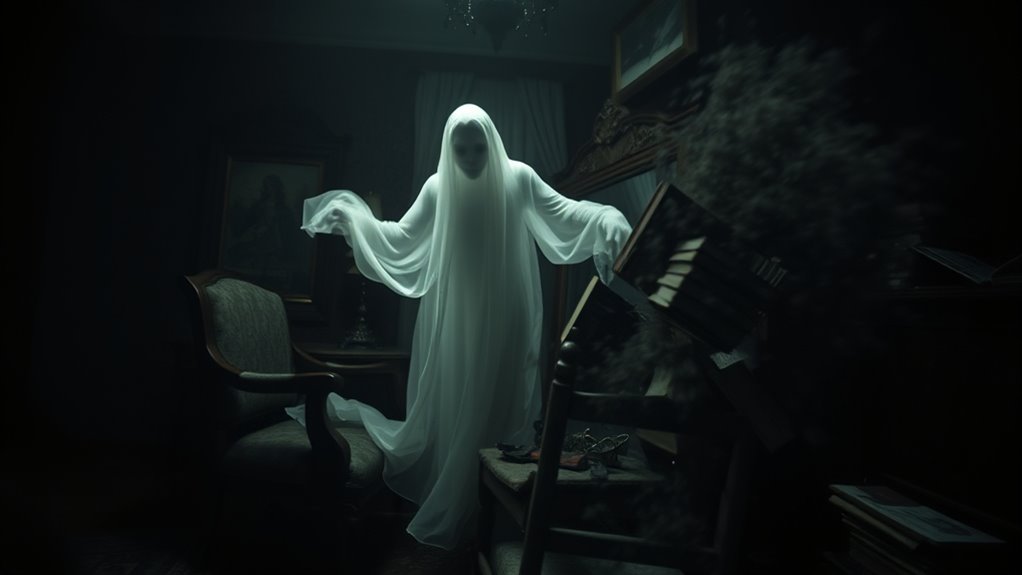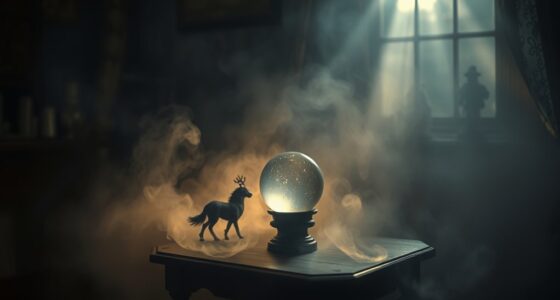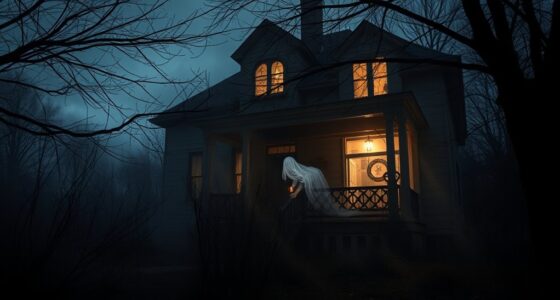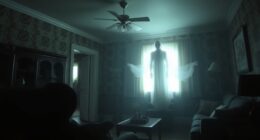A ghost is typically the spirit of someone who has died and lingers due to unresolved issues or emotional ties, appearing as calm or subtle figures like shadows or whispers. In contrast, a poltergeist involves energetic disturbances driven by subconscious forces, causing loud noises, objects flying, and chaos without necessarily involving a spiritual presence. If you want to understand how to tell them apart more clearly, keep exploring the differences and their behaviors.
Key Takeaways
- Ghosts are spirits of the deceased; poltergeists are energetic phenomena not necessarily linked to spirits.
- Ghosts usually appear calmly and subtly, while poltergeists produce loud, violent, and chaotic disturbances.
- Ghost manifestations often involve whispers or brief apparitions; poltergeists cause banging, objects flying, or physical damage.
- Ghosts are connected to emotional ties or unresolved issues; poltergeists often stem from subconscious psychic energy.
- Ghosts tend to linger in familiar, meaningful locations; poltergeists can appear suddenly and unpredictably in various settings.
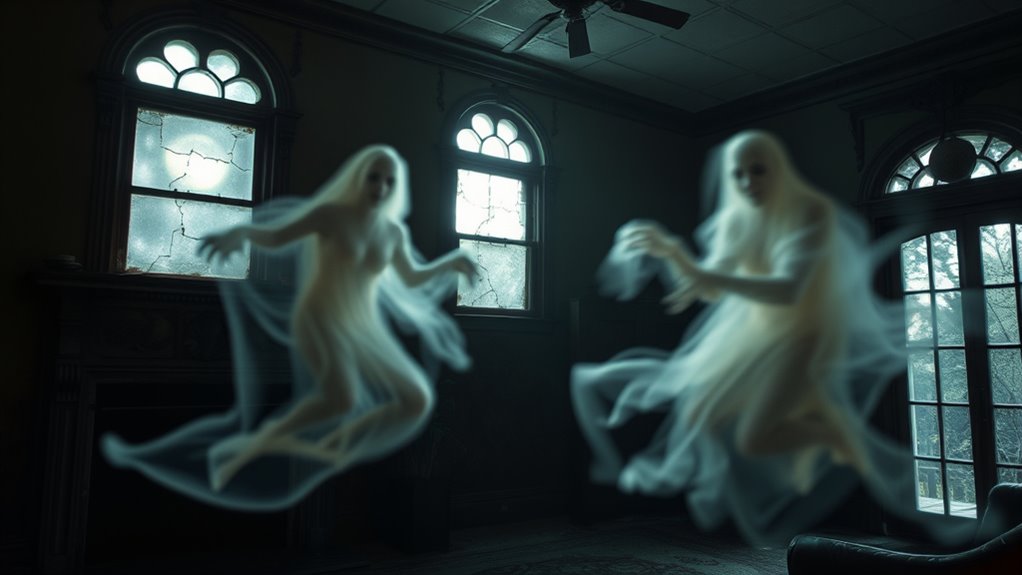
Many people confuse ghosts and poltergeists, but these phenomena have distinct characteristics that set them apart. When you encounter what seems like a spiritual presence, understanding the differences can help you interpret what’s happening around you. Ghosts are typically perceived as the spirits of the deceased, lingering in a space because they have unresolved issues or strong attachments. Their haunting manifestations tend to be subtle — apparitions, cold spots, or objects moving slowly. These manifestations often seem calm or even benign, as if the spirit is trying to communicate or seek closure. Ghosts usually appear in specific locations that held significance for them, like old houses or places of trauma, and their presence is often linked to emotional ties to a place or person.
In contrast, poltergeists are more active and unpredictable. The term itself comes from German words meaning “noisy spirit,” and that noise is exactly what you’re likely to notice. You might hear banging, knocking, or loud crashes with no apparent source. Poltergeist activity often involves physical manifestations like objects being thrown or moved violently, sometimes even injuring those nearby. Unlike ghosts, poltergeists aren’t necessarily tied to a spiritual presence of a deceased person. Instead, they tend to be linked to intense emotional states, especially adolescence or stress, and some experts think they originate from subconscious energies rather than spirits. The haunting manifestations of poltergeists are energetic, aggressive, and chaotic, making them more frightening and harder to ignore. Additionally, understanding energy origins can provide insight into why these phenomena occur and how they differ from spiritual apparitions. These energetic disturbances are often triggered by psychic activity, which can amplify the chaos and unpredictability of poltergeist phenomena. Recognizing the difference in behavior can help distinguish between a haunting and an energetic disturbance. You’ll also notice differences in how these phenomena respond to your attempts at communication. Ghosts may seem aware of your presence, sometimes attempting to relay messages or appear when they believe they’re seen. Their manifestations can be gentle, like whispers or fleeting shadows, and they often linger in familiar spaces. It’s also worth noting that some researchers believe that manifestation types are influenced by the nature of the entity involved, affecting how they choose to communicate. Poltergeists, however, tend to be more unpredictable and less communicative. Their activity can escalate suddenly, with loud noises or violent movements, often without warning. They’re less about spiritual presence and more about disruptive energy, making them seem almost malicious in their behavior.
Frequently Asked Questions
Can Ghosts and Poltergeists Coexist in the Same Location?
You might wonder if ghosts and poltergeists can coexist in the same location. While both are forms of spiritual presence, haunting phenomena caused by spirits or energetic disturbances may overlap. Ghosts tend to manifest as apparitions or residual energy, while poltergeists are more active, causing physical disturbances. So, yes, they can coexist, creating a complex and intense haunting experience where different types of spiritual presence interact within the same space.
Are Poltergeists Typically Malevolent or Benign?
Perplexed about poltergeists? You’ll find they’re typically malevolent spirits that stir up trouble, causing chaos and creating a creepy climate. Unlike benign apparitions, which are harmless and often comforting, poltergeists act aggressively, unsettling the space with noisy, destructive disturbances. So, if you’re experiencing unexplained uproars, it’s likely you’re dealing with a malevolent spirit rather than a benign presence. Stay cautious and consider seeking professional paranormal help.
Do Certain Cultures Interpret Ghosts and Poltergeists Differently?
You’ll find that cultural beliefs and spiritual interpretations shape how different societies understand ghosts and poltergeists. In some cultures, ghosts are seen as ancestors’ spirits, while others view them as restless souls needing closure. Poltergeists might be interpreted as mischievous spirits or manifestations of emotional stress. These diverse beliefs influence how people perceive these phenomena, emphasizing the importance of cultural context in understanding supernatural activity across the world.
How Can I Tell if a Spirit Is a Ghost or Poltergeist?
You notice a sudden, relentless storm of objects crashing around your room—this is likely a poltergeist’s rage, with intense paranormal activity and disruptive spirit manifestation. A ghost, however, tends to appear calmly, often as a fleeting apparition or gentle whisper. To tell the difference, observe the behavior: poltergeists cause chaos, while ghosts are more subdued. Your instincts and the pattern of activity guide you in identifying the spirit’s true nature.
Are There Scientific Explanations for Ghost and Poltergeist Activity?
You might wonder if there’s scientific proof for paranormal research involving ghosts and poltergeists. While some studies suggest unusual activity, scientific skepticism remains strong because many phenomena can be explained by psychological or environmental factors. Researchers haven’t confirmed a definitive scientific explanation yet. If you’re exploring these experiences, consider both the mysteries and the skepticism, keeping an open mind while understanding the limits of current scientific evidence.
Conclusion
So, now that you know the difference, you can confidently tell your friends that ghosts are the shy, ethereal spirits who quietly haunt your house, while poltergeists are the mischievous troublemakers throwing furniture around just for fun. Just remember, if your lamp starts dancing or your fridge starts singing, it’s probably a poltergeist auditioning for the next haunted house reality show. Stay alert, and maybe keep a broom handy—just in case!
